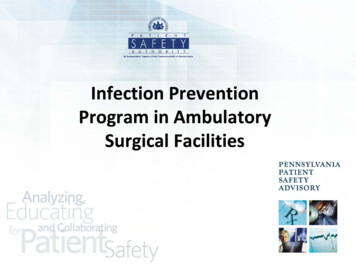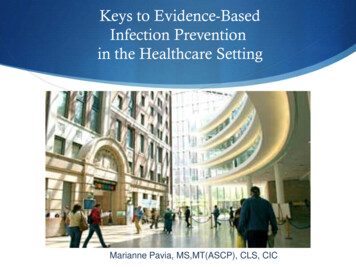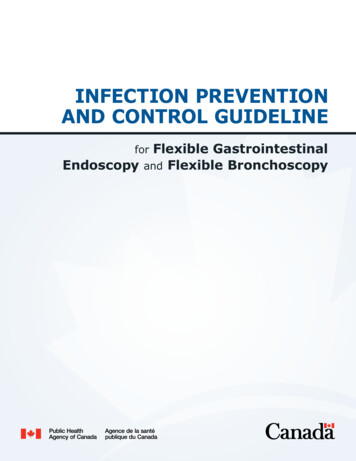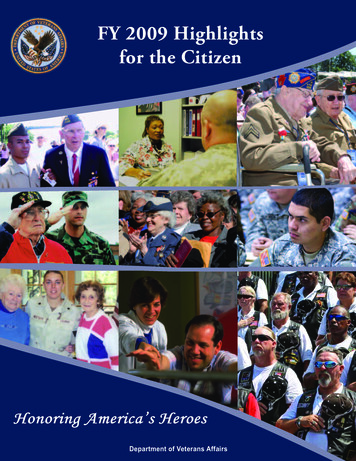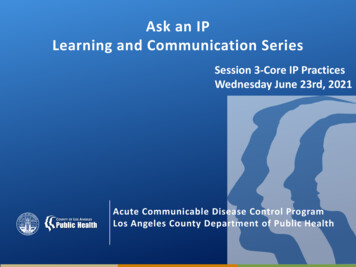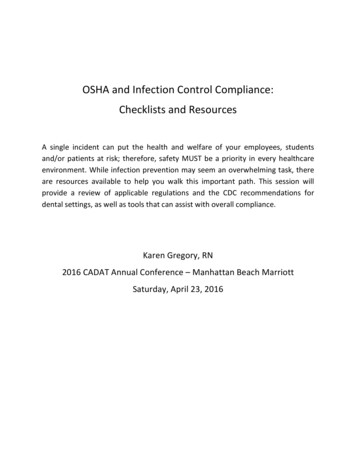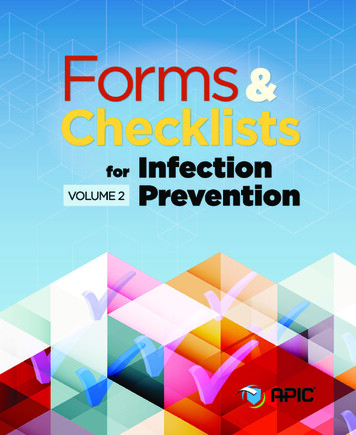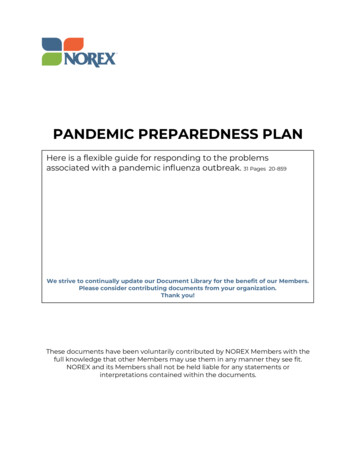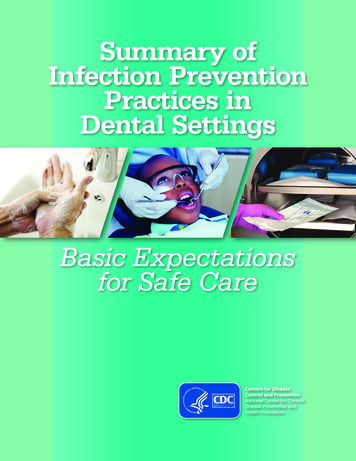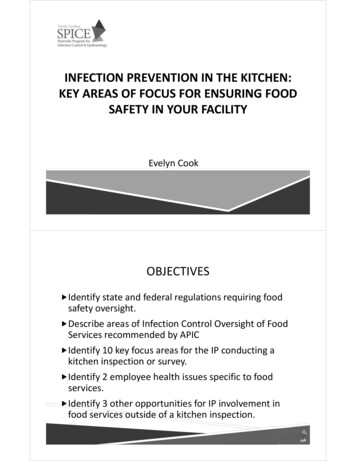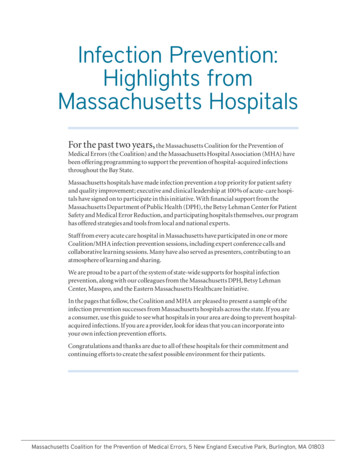
Transcription
Infection Prevention:Highlights fromMassachusetts HospitalsFor the past two years, the Massachusetts Coalition for the Prevention ofMedical Errors (the Coalition) and the Massachusetts Hospital Association (MHA) havebeen offering programming to support the prevention of hospital-acquired infectionsthroughout the Bay State.Massachusetts hospitals have made infection prevention a top priority for patient safetyand quality improvement; executive and clinical leadership at 100% of acute-care hospitals have signed on to participate in this initiative. With financial support from theMassachusetts Department of Public Health (DPH), the Betsy Lehman Center for PatientSafety and Medical Error Reduction, and participating hospitals themselves, our programhas offered strategies and tools from local and national experts.Staff from every acute care hospital in Massachusetts have participated in one or moreCoalition/MHA infection prevention sessions, including expert conference calls andcollaborative learning sessions. Many have also served as presenters, contributing to anatmosphere of learning and sharing.We are proud to be a part of the system of state-wide supports for hospital infectionprevention, along with our colleagues from the Massachusetts DPH, Betsy LehmanCenter, Masspro, and the Eastern Massachusetts Healthcare Initiative.In the pages that follow, the Coalition and MHA are pleased to present a sample of theinfection prevention successes from Massachusetts hospitals across the state. If you area consumer, use this guide to see what hospitals in your area are doing to prevent hospitalacquired infections. If you are a provider, look for ideas that you can incorporate intoyour own infection prevention efforts.Congratulations and thanks are due to all of these hospitals for their commitment andcontinuing efforts to create the safest possible environment for their patients.Massachusetts Coalition for the Prevention of Medical Errors, 5 New England Executive Park, Burlington, MA 01803
Table of Contents1. Baystate Medical Center — Hospital-Acquired Infection Reduction2. Baystate Medical Center — Neonatal Intensive Care Unit (NICU)3. Baystate Franklin Medical Center — Ventilator Associated Pneumonia4. Baystate Franklin Medical Center — Hand Hygiene5. Beth Israel Deaconess Medical Center — Ventilator Associated Pneumonia6. Brigham and Women’s Hospital — Hand Hygiene7. Cambridge Health Alliance — Ventilator Associated Pneumonia8. Cape Cod Hospital — Ventilator Associated Pneumonia9. Caritas Christi Healthcare System — Methicillin-Resistant Staph.Aureus10. Cooley Dickinson Hospital — Methicillin-Resistant Staph. Aureus11. Emerson Hospital — Catheter-Associated Urinary Tract Infections (CAUTI)12. Emerson Hospital — Central Line Associated Blood Stream Infections13. Fairview Hospital — Reduction of Multi Drug Resistant Organisms14. Health Alliance — Ventilator Associated Pneumonia15. Heywood — Methicillin-Resistant Staph. Aureus (MRSA)16. Lawrence General Hospital — Employee Influenza Vaccination Rate17. Lawrence General Hospital — Ventilator Associated Pneumonia18. Lowell General Hospital — Hand Hygiene19. Massachusetts General Hospital — Central Line Related BloodStream Infections20. Massachusetts General Hospital — Hand Hygiene21. Mercy Medical Center — Ventilator Associated Pneumonia22. MetroWest Medical Center — Ventilator Associated Pneumonia23. Milford Regional Hospital — Reducing Indwelling Catheter Use To Reduce UTIs24. Milford Regional Hospital — Hand Hygiene to Reduce C.Difficile Infection25. Mount Auburn Hospital — Employee Influenza Vaccination Program26. Mount Auburn Hospital — Hand Hygiene27. Mount Auburn Hospital — Ventilator Associated Pneumonia28. New England Baptist Hospital — Blood Pressure Cuffs Cleaning29. New England Baptist Hospital — Surgical Site Infections (SSI)30. Quincy Medical Center — Catheter-Related Blood Stream Infections (CRBSI)31. Quincy Medical Center — Hand Hygiene and Contact Precautions32. Tufts Medical Center — Hand Hygiene33. U Mass Memorial Medical Center — Central Line Associated BloodStream Infections34. Winchester Hospital — Reduce Hospital-Acquired Multi Drug Resistant Organisms
Baystate Medical Center — Hospital-Acquired Infection ReductionMary Ellen Scales, RN, MSN, CIC, (413) 794-4782; mary.ellen.scales@bhs.orgInfection or Practice Targeted:Teams and engagement of staff in critical care areas to reduce Hospital-Acquired Infections (HAIs)Infection prevention and performance improvement rounds in critical care areas empower staff to engage in infection prevention activities. Teamrounds started in 2008 after positive deviance education and continue to show improvement in patient safety with interventions employed.Results:Reduction in HAI for ICUICU Catheter Related BSI: Jan 04 – March 09ICU – VAP 20 Quarters: Jan 04 – March 091
Do These Results Reflect the Whole Hospital or Specific Units?Adult ICUDescribe Briefly the Changes Made to Achieve These Results:Monthly infection prevention performance improvement rounds are scheduled in the adult Intensive Care Unit (ICU) to identify issues with HAIreduction. Rounds are posted to let staff know and to engage them in the multidisciplinary rounds. Rounds include staff education, questions,feedback on HAI reduction practices and observation of barriers or gaps in processes. Those present on rounds include unit management, MDs,RNs, Pharmacy, Respiratory Therapy and any other discipline that is in the unit at the time. Minutes from rounds are written and follow up isperformed to completion. Some issues identified are hospital wide and generate subgroups or other committees to handle or manage issues thatare bigger than the unit itself.Most Important Lessons Learned From This Work:Unit staff engagement in HAI prevention processes helps to promote the team effort in patient safetyn Unit staff are aware of issues that occur more so than outside consultantsn Validating unit staff concerns help them to be part of the solution and emphasizes that their input is valuedn Engaging front line staff helps to share the responsibility for follow upSeeing improvement in issues they identify lets them know that their feedback is important to the process.Baystate Medical Center — Neonatal Intensive Care Unit (NICU)Mary Ellen Scales, RN, MSN, CIC, (413) 794-4782; mary.ellen.scales@bhs.orgInfection or Practice Targeted:nnReducing the incidence of hospital-acquired infections must be a unit goalMotivating staff to make a difference and see positive changesResults:Zero Central Line-Associated Blood Stream Infections (CLABSI) in NICU for 300 days, one Ventilator Associated Pneumonia (VAP) in 4 years,100% compliance with before and after care hand hygiene compliance.Do These Results Reflect the Whole Hospital or Specific Units?NICU / CCN specificDescribe Briefly the Changes Made to Achieve These Results:All staff are engaged in prevention activities for HAIs. Practice Standards must be implemented, understood and followed by all staff members.Practice standards to reduce Catheter-Related Bloodstream Infections (CRBSI)n Sterile Technique is used when changing all IV’s infused through central lines and TPN’sn IV ports prepped using alcohol and friction for 1 to 2 minutes prior to medication administrationn Gloves worn when giving IV medsn Initial PICC Lines dressings changed after 24 hours from insertion if bloodyn IV Lines to be kept away from diaper arean Gloves to be worn when changing diapersn Hands washed after removing gloves and before feedingn Aggressive medical management to remove central lines as soon as possiblePractice standards to reduce Ventilator Associated Infections (VAP)n Keep the head of the bed (HOB) elevated 15-30 degreesn Closed in-line suction used on all vented patientsn Separate system for oral suctioningn Vent circuits changed every 7-daysn Keep circuit connected during position changesn Keep water drained from ventilator tubingn Aggressive medical management to extubate as soon as possibleStaff plus environmental services are responsible for the clean, safe environment: Environmental Practice Standardsn Clean countertops every 4 hours with a disinfectant solutionn Minimize clutter at the bedsiden Remove any unnecessary equipment including IV PumpsHand hygiene became the binding force and the key to our latest success after all other measures were implemented. We teach ourparents, family members, visitors, and ourselves how important it is. Reports include details on compliance for MDs, PAs, NNP, supportstaff (RTs, etc) as well as bedside nursing staff. Implement a strong hand hygiene program.n Hand sanitizers placed at all patient bedsides and on all computer mobile devicesn Monitoring is conducted for hand hygiene compliancen Audit results are shared with the staff2
nn“Knock on the Door”: Hand Hygiene Practice Model introducedScreen savers on the unit computer depict prompts as reminders to staff to perform hand hygieneEngagement includes sharing results and improving our care; the babies thank us.n In our unit we have a small “Wipe Off Board”n Infection Control keeps the board updatedn The board is visible for everyone to see including family membersn The board has actually started to bring out a competitive flavorMost Important Lessons Learned From This Work:Motivating staff and engaging them at all levels to improve patient safety. Knowledge is power, and a real time reflection of how we are doinghelps to ‘put a face’ on why we are doing what we are doing.NICU CVL/PICC – Related BSIby BirthweightJan 2006 – March 2009NICU CVL Line DaysJan 2006 – March 20093
NICU UC/CVL/PICC Related BSICumulative Birth WeightJan 2006 – March 2009 300 days since last CLABSI 8/6/08NICUHand Hygiene Compliance Rate4
NICU VAP Rate by BirthweightJan 2005 – March 2009Baystate Franklin Medical Center — Ventilator Associated PneumoniaMary Ellen Ahearn, RN, BSN, CIC, EMT-B, (413) 773-2232; maryellen.ahearn@bhs.orgInfection or Practice Targeted:Ventilator Associated Pneumonia (VAP)Results:Since 2001, there has been one instance of VAP at BFMC. VAP-prevention bundle implementation was January 2007. To date there have been noadditional cases.ICU Ventilator Associated Pneumonia/Vent Days Rate FY99Q2 – FY09Q1VAP Bundle Compliance % and Infection Rates5
Do These Results Reflect the Whole Hospital or Specific Units?ICU only. ICU is the only unit that has ventilated inpatients.Describe Briefly the Changes Made to Achieve These Results: multidisciplinary team began meeting in the summer of 2006 to implement the Institute for Healthcare Improvement (IHI) VAP bundleAwhich included an assessment of the practice at that time.n Education regarding the IHI bundle for VAP was completedn Developed data collection tooln Developed VAP care set for electronic medical recordn E xtensive communication to medical staff and hospital staff involved in care of ventilated patientsn Ongoing monitoring of practice, use of the bundle and clinical documentation occurredn A bright yellow sticker on the progress notes is used to flag delivery of the vent bundle in ICUn Feedback process in place if bundle not ordered in and/or not documented in clinical recordn Implementation of the entire IHI bundle was January 1, 2007nMost Important Lessons Learned From This Work: aking it possible for frontline healthcare workers involved in the care of ventilated patients to actively participate on the performanceMimprovement team was key for this work to be successful.n Strong committed physician leader to support the project.n Sharing progress and success frequently with team and hospital after the implementation of the IHI VAP bundle.nBaystate Franklin Medical Center — Hand HygieneMary Ellen Ahearn, RN, BSN, CIC, EMT-B, (413) 773-2232; maryellen.ahearn@bhs.orgInfection or Practice Targeted:Hand HygieneResults:Hand hygiene compliance rates have steadily risen from approximately 55% to over 75% before and after patient/environment contact since 2004.Hand Hygiene Prior to Patient ContactDo These Results Reflect the Whole Hospital or Specific Units?These results represent sixteen clinical units in the hospital.Describe Briefly the Changes Made to Achieve These Results: multidisciplinary Hand Hygiene Quality Action Team (H2 QAT) chartered in July, 2004. Baseline observation data as well as a selfAassessment data gathered.n Three trials completed to determine effect of various approaches to education about hand hygiene on three clinical units.n Hospital-wide clinical implementation in March 2005 required departments to include hand hygiene data in their departmentperformance improvement plan.n Completed first successful outreach program with five local elementary schools in fall 2005 and replicated it for another three yearswith eight more elementary schools in our county.n Since March 2008, implemented Baystate Health’s Hand Hygiene Task Force interventions which have renewed BFMC’s energy to improvehand hygiene compliance.nMost Important Lessons Learned From This Work:n6 Use a staff-awareness hand hygiene survey tool to gather data.
se data to plan for high-impact interventions to increase compliance.U Provide a Hand Hygiene Manager Toolkit which supports customization to meet the specific hand hygiene needs of their unit.n Plan for unit-based champions to act as role models and educational resources.n Hold staff accountable for their personal practice of hand hygiene compliance.n Share hand hygiene compliance rates frequently with frontline healthcare providers and hospital leaders.n Work in conjunction with community partners to create colorful, fun posters to remind healthcare providers, patients, students and visitorsabout the importance of hand hygiene.nnBeth Israel Deaconess Medical Center — Ventilator Associated PneumoniaMichael D. Howell, MD, MPH, (617) 632-7687; mhowell@bidmc.harvard.eduInfection or Practice Targeted:Ventilator Associated PneumoniaResults:Reduction of VAP rates by about 90% (see run chart). We have seen progressive reduction year-over-year during this three-year effort. Achievement of high reliability (99-100%) application of the ventilator bundle did NOT result in elimination of VAP. Progressive reductions were seen withimprovements in oral care and with the addition of chlorhexidine decontamination.91% reduction*only Feb and March assessedIn addition, improvement in ventilator-associated pneumonia prevention strategies was temporally associated with increased ICU throughput(in a stable number of beds), apparently mediated through a reduced length of stay.7
Do These Results Reflect the Whole Hospital or Specific Units?We collect process measures in all ICUs, and sample VAP rates in four ICUs.Describe Briefly the Changes Made to Achieve These Results:We found that highly reliable implementation of the Institute for Healthcare Improvement Ventilator Bundle was associated with reductions in VAP rates.However, even consistent 99-100% implementation of the Ventilator Bundle did not result in elimination of VAP. Therefore, we focused on improving oralcare. This resulted in further reductions of VAP rates, but did not result in elimination. Next, we added oral decontamination with twice-daily chlorhexidine. This resulted in further reductions of VAP rates. Leadership of this work included physicians, nurses, and respiratory therapists.Most Important Lessons Learned From This Work:Probably the most important single intervention was dedication of a Clinical Nurse Specialist to the work.Brigham and Women’s Hospital — Hand HygieneHeidi Crim, RN, BSN, (617) 525-6793; hcrim@partners.orgInfection or Practice Targeted:Hand hygiene and prevention of hospital acquired infectionResults:The hospital audits departmental performance measures and the Emergency Department (ED) was doing poorly, showing 36% compliance.The ED developed a multi-disciplinary Quality Improvement campaign and the results were spectacular. From February 2008 to February 2009,the rates climbed from 36% to 96%. Since February 2009, the monthly results remain above 90%.Do These Results Reflect the Whole Hospital or Specific Units?Emergency Department onlyDescribe Briefly the Changes Made to Achieve These Results: athered key stakeholders (leaders with employee influence)G Identified barriers (lack of equipment, lack of education and understanding of the problem)n E xcited the staff with campaignn Robust auditing with real-time feedbacknnMost Important Lessons Learned From This Work:The importance of robust auditing, feedback and gathering the key stakeholders.Cambridge Health Alliance — Ventilator Associated PneumoniaDeb Bears, RN, (617) 499-8316; dbears@challiance.orgInfection or Practice Targeted:From Jan-Jun 2009 our team will reduce MRSA VAP to no more than 1 case in the Whidden ICU.Results:BaselineVentilator Associated PneumoniaVentilator Associated PneumoniaWhidden ICUDo These Results Reflect the Whole Hospital or Specific Units?These are the results for the Whidden ICU. Plans are to learn from this unit and share with the Cambridge ICU using the “Discovery and Action”dialogue to see what the staff feels will work best for them.8
Describe Briefly the Changes Made to Achieve These Results:Team members – it was felt that all staff that touched the patient in any way should be part of our team. Members include Nursing,Respiratory, Housekeeping, Infection Prevention, Quality Management, Medical Staff and Campus Leadership.Changes that have been implemented:n Reached out to Senior Leadership and Medical Staffn More robust monitoring of HOB elevation and compliance with hand hygiene and contact precautionsn Precaution Stop signs developed for room entry and exit delineating the appropriate order for donning/removing personal protectiveequipment and hand hygiene.n Respiratory Therapy documented level of HOB on vent sheets, corrected the patient’s position if not 30 degrees and alerted the nursingstaff to any deficiency.n Information for visitors in multiple languagesn Coat racks for visitors in lounge for those going into precaution roomsn Discussions and continued education with staffn Weekly rounds with more staff nurse involvement (empowerment)n L arger barrels in rooms for disposal of gownsn Trial of subglottic suction ET tubesn ED involvement in piloting subglottic ET tubesn Ventilators numbered for easy identificationn Monitoring of reintubation raten Housekeeping adopted the Shine program to monitor cleaning technique and shared this with Respiratory for assessing the qualityof ventilator surfacing cleaning.n Oral Care Policy revisedn Signs above beds to inform visitors not to adjust head of bed and other disciplines to return bed to 35 degrees after treatment.n Investigate and work on the process for Sedation Vacationn New – Daily rounding: Charge Nurse and Respiratory TherapistMost Important Lessons Learned From This Work:I nvolvement of all disciplines is essential. Listening to staff for their ideasn Active intervention (coaching) is effectiven Reserve time to meet on a regular basis and have leadership communicate that the project is an institutional priorityn Communicate, display and discuss all process and outcome measures with all stakeholdersn Beneficial to participate in this Coalition effortnnCape Cod Hospital — Ventilator Associated PneumoniaGigi Dash, RN,MS, CIC, (508) 862-5703; gpdash@capecodhealth.orgInfection or Practice Targeted:VAPResults:CCH Ventilator Associated Pneumonia Rate Per1000 Ventilator DaysCCH VAP Costs Avoided andLives Saved 20082005 vs. 2006 vs. 2007 vs. 20089
VBC Pre-TICU vs. Post TICUCape Cod Hospital VAP Bundle Compliance 5/07 – 9/07Percentage ComplianceDo These Results Reflect the Whole Hospital or Specific Units?ICU, CCU, CSICUDescribe Briefly the Changes Made to Achieve These Results:The team learned of the success of the VHA Transformation of the ICU (TICU) program in increasing VAP Bundle Compliance (VBC) and reducingVAP rates in other hospitals. The TICU program engages staff in measuring Ventilator Bundle Compliance (VBC) utilizing web-based software thatprovides real time feedback via reports benchmarking VAP rate / VBC with comparable hospital ICUs. In addition, quarterly content calls,educational programs, listserv and a share and learn site is provided for staff.In April 2007 we joined the program, educated staff and began measurement of ICU mortality rate, percent of patients with Length of Stay (LOS) 7 days, Average ICU LOS, Average number of ventilator days, optimal pain management, and VAP rate / VBC.Most Important Lessons Learned From This Work:We believe that the success we have experienced is directly attributable to the commitment of our ICU Team to VAP reduction by participation inthe VHA TICU Program. The program has facilitated engagement of our entire ICU Team in measuring our VBC and has provided real timefeedback of our performance allowing us to correct issues as they occur and celebrate successes. We believe that this model can be replicated inother facilities to reduce VAP and thereby increase patient safety.Caritas Christi Healthcare System — Methicillin-Resistant Staph.Aureus (MRSA)Maria Gray, MT (ASCP), (617) 789-2591; maria.gray@caritaschristi.orgInfection or Practice Targeted:Reducing Multi-Drug Resistant Organism (MDRO) Hospital Acquired InfectionsResults:10
Do These Results Reflect the Whole Hospital or Specific Units?The results above represent the infection rates of the whole hospital system.Describe Briefly the Changes Made to Achieve These Results:The Caritas Christi Healthcare aim is to reduce hospital acquired infections from MRSA, Vancomycin-Resistant Enterococci (VRE) and C.difficile by30% over 18 months in specific hospital pilot locations (including intensive care units and possibly identified medical/surgical care unit) byadopting both the primary driver strategies for prevention of transmission and infection as designed by the IHI Impact community. Once thepilot period is concluded and all tests of change have validated the intended outcome, these tested processes will be spread to all Caritasinpatient units to maximize the intent to eliminate hospital acquired infections from MRSA, VRE and C. difficile at all Caritas hospitals by 2010.In May 2008 all the Caritas presidents signed a pledge and designated a project leader and team members for specific roles outlined by an expertpanel. The expert panel developed change packages around four specific interventions which include:n Identify patients with active surveillance cultures (ASC)n Contact precaution standards for infected/colonized patientsn Decontamination of the environment and equipmentn Hand hygienen Processes to eliminate central line and ventilator associated infections (already in place).On May 20, 2008, the designated team members and senior leadership along with representation from Board of Trustees gathered for a kick-offmeeting. The elements of each change package were presented to the sites and binders with details to implement were distributed to localproject leaders. Following the kick-off meeting the local project leaders met monthly with the Caritas Christi HAI project leader/data manager todiscuss barriers to implementation, successes and results. The sites also completed a monthly senior leader report which includes compliancerates with each intervention and infection rates. Graphs of the process measures and outcome measures are distributed to the local teams,senior leadership and posted on the intranet.Most Important Lessons Learned From This Work:Important lessons learned from implementing the HAI initiative include:n S enior leadership/staff/MD buy-in is key to successn Be open to tweaking the process to accommodate for different populationsn Project leaders are instrumental to ensuring maintaining positive resultsCooley Dickinson Hospital — Methicillin-Resistant Staph. Aureus (MRSA)Linda Riley, M.Ed, RN, BC, CIC, (413) 582-2135; linda riley@cooley-dickinson.orgInfection or Practice Targeted:Reduce transmission of MRSA on med-surg, telemetry and critical care units.Results:Compared with the one year prior to any MRSA screening program(Q3 ’06-Q2 ’07), during the MRSA DNA PCR screening period therewas a 68% drop in rate of Surveillance MRSA infections*.While the total number of Surveillance Infections*dropped between 2007 and 2008, the percent attributableto MRSA dropped faster% of SURVEILLANCE INF WHICH ARE DUE TO MRSA(VAP, CCU/FC-UTI, CVC-BSI, SSI)25% of TOTAL SURV A Surveillance Infection DeathsFor the first time in 4 years, in 2008 there were NOdeaths due to Surveillance MRSA* Infections.The total Surgical Site Infection rate (# Inf/100 procedures)dropped 60% from 2007 to 2008 while the MRSA SSIrate declined 81%11
Do These Results Reflect the Whole Hospital or Specific Units?n These results reflect same day and in-patient surgery, and patient care on med-surg, telemetry and critical care units.Describe Briefly the Changes Made to Achieve These Results: and hygiene campaign with signage, screen savers, education, observations and feedbackH Improved environmental cleaningn Continued use of contact precautions with cohorting of patients (decision tree developed to assist with bed assignment process)n Maintenance of list of MDRO patients with alert on medical recordn Active surveillance cultures of ED patients prior to admission via Polymerase Chain Reaction (PCR) testing with results availablewithin 1 – 2 hoursn S creening for Staph. aureus and MRSA for all total pre-op joint replacement patients with bactroban for positive MSSA/MRSA; hibiclens showersX5 days for MRSA; and Sage CHG wipes (whole body) the night before and morning of surgery for ALL joint replacement patients.n Volunteers assemble swabs and patient teaching materials in small biohazard bags which are then used to send specimens to labn Quarterly data posted in all patient care units, environmental servicesn Instructions on preventing Surgical Site Infections (SSIs) mailed to surgical patients pre-opnnMost Important Lessons Learned From This Work:nnI t takes a village to prevent infections Continuous feedback and communication are criticalEmerson Hospital — Catheter-Associated Urinary Tract Infections (CAUTI)Virginia Caples, RN, CNOR, (978) 287-3211; vcaples@emersonhosp.orgInfection or Practice Targeted:Catheter-Associated Urinary Tract Infections (CAUTI)Results:From July through December 2008, we had an average of 666 device days per month and an average of 9.5 infections each month with a 14%infection rate. From January through April 2009, we had an average of 613 device days per month with 5.5 infections and an infection rate ofabout 9%.Do These Results Reflect the Whole Hospital or Specific Units?All unitsDescribe Briefly the Changes Made to Achieve These Results:In late December we began the “CAUTI task force”. The task force included the quality and patient safety nurse, a nurse educator, a practicecouncil/educator nurse, the NSQIP nurse and the Infection Preventionist. We began looking at the practice of Foley usage and care of the Foleycatheters once they were inserted. We realized that Foley catheters were placed for convenience in some cases. This was a practice that wewanted to stop.The task force began by reaching out to the care givers for feedback on Foley usage and patient needs and outcomes. We performed an extensiveliterature search surrounding catheters and costs of infections. It seemed that Foley care and practice at the bedside at Emerson Hospital was inline with the current literature. We realized that we needed to decrease device days and increase awareness surrounding this need. We began toeducate the nurses and spoke to many of the physicians about Foley usage and the need to minimize device days in order to help minimizeinfection rates.We have a physician champion (who just happens to be an urologist) and we are educating staff and physicians alike. We meet formallyevery other week but we also perform “huddles” with staff on the floors about once a week. As you can see from our recent data, the device dayshave dropped as have the infection rates. We will begin to implement the “Foley Removal Protocol” soon which will allow nurses to remove aFoley catheter if and when certain criteria are met. We hope that this will eliminate unnecessary device days and drive infection rates downeven further.Most Important Lessons Learned From This Work:Teamwork, teamwork, teamwork!Emerson Hospital — Central Line Associated Blood Stream Infections (CLABSI)Virginia Caples, RN, CNOR, (978) 287-3211; vcaples@emersonhosp.orgInfection or Practice Targeted:Central Line Associated Blood Stream Infections (CLABSI)Results:From January through August 2008, we had 5 CLABSI’s in the CCU. (rate 2%)We have had 714 infection-free device days and 242 total days without a CLABSI in the CCU (rate 0%)12
Do These Results Reflect the Whole Hospital or Specific Units?CCUDescribe Briefly the Changes Made to Achieve These Results:We began an extensive reeducation program through the efforts of the infusion nurse, CCU nurse educator and the Infection Preventionist. Wemet with staff (all new orientees went through a rigorous and intense process surrounding central lines) regarding the insertion and care of lines.We would meet briefly (huddle) a few minutes at a time every week or so to see what was working and what we needed to improve upon.I credit the infusion nurse, the educators, the staff, and MD’s in this endeavor. What a huge pat on the back they deserve. We will begin to utilizeour central line insertion checklist as of June 15, 2009 to continue to ensure quality patient care surrounding the insertion of all central lines.Most Important Lessons Learned From This Work:Teamwork, teamwork, teamwork!Fairview
10. Cooley Dickinson Hospital — Methicillin-Resistant Staph. Aureus 11. Emerson Hospital — Catheter-Associated Urinary Tract Infections (CAUTI) 12. Emerson Hospital — Central Line Associated Blood Stream Infections 13. Fairview Hospital — Reduction of Multi Drug Resistant Organisms 14. Health Alliance — Ventilator Associated Pneumonia 15.
